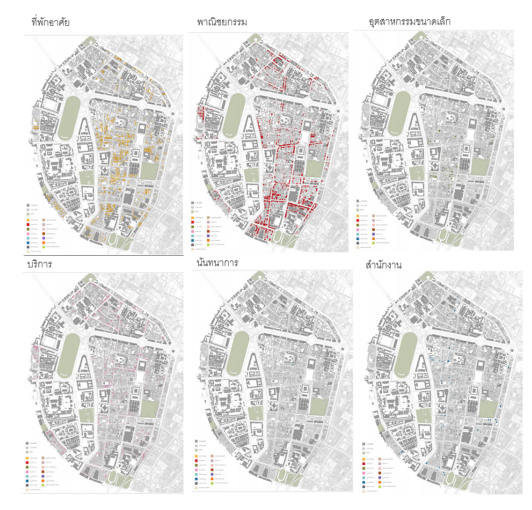Representation of Identity Function Through Use Transformation of Shophouse on The Rattanakosin Island
Main Article Content
Abstract
“Changing of Identity: A Case Study of Shophouse on the Rattanakosin Island after Use Transformation Process” aims at explaining changes of place-identity through understanding of identity formation processes that embrace physical environment, way of living, activity and meaning-given to shophouse during fluctuating situation occurring in place. To understand expression of place attitude and activity toward change of physical environment, grounded theory is employed as a qualitative method to proceed research activities, through physical environment survey, behavioral observation and in-depth interview. Subsequently, issues contributing to change of use among shophouses are synthesized and discussed through the process of use transformation on which activity and action should occur in each stage. From the analysis it can be concluded that change of place-identity of individual and group of people in the area of Rattanakosin Island is divided into 3 main approaches: 1) continuity of existing identity 2) changing of identity and 3) construction of identity, which is differently through expression of self-congruity, self-adaptation and self-identification.
Downloads
Article Details

This work is licensed under a Creative Commons Attribution-NonCommercial-NoDerivatives 4.0 International License.
All material is licensed under the terms of the Creative Commons Attribution 4.0 International (CC-BY-NC-ND 4.0) License, unless otherwise stated. As such, authors are free to share, copy, and redistribute the material in any medium or format. The authors must give appropriate credit, provide a link to the license, and indicate if changes were made. The authors may do so in any reasonable manner, but not in any way that suggests the licensor endorses you or your use. The authors may not use the material for commercial purposes. If the authors remix, transform, or build upon the material, they may not distribute the modified material, unless permission is obtained from JARS. Final, accepted versions of the paper may be posted on third party repositories, provided appropriate acknowledgement to the original source is clearly noted.
References
Boonprasong, P. (2017). USE TRANSFORMATION PROCESS OF SHOPHOUSES: A CASE STUDY OF THA TIEN’S SHOPHOUSE, BANGKOK. (Doctor of Philosophy), Chulalongkorn University. Retrieved January 24, 2019 from http://cuir.car.chula.ac.th/handle/123456789/58238.
Boonprasong, P. (2019). Place Identity in Use Transformation Process of Old Building in The Old Town. Journal of Architectural/Planning Research and Studies, 16 2.2019: July - December, 31-47. Retrieved July 15, 2020 from https://so02.tci-thaijo.org/index.php/jars/article/view/175256.
Boonprasong, P. (2020). Rai-ngan Wichai Chabap Sombun Rueang Kan Praeplian Khong Atta lak Korani Sueksa Tuekthaeo Nai Krung Rattanakosin Phailang Kan Plianplaeng Kan Chaisoi [Changing of Identity: A Case Study of Shophouse on the Rattanakosin Island after Use Transformation Process]: Thailand Science Research and Innovation.
Bullen, P. (2004). Sustainable Adaptive Reuse of the Existing Building Stock in Western Australia. Paper presented at the 20th Annual ARCOM Conference, Heriot Watt University. Retrieved May 24, 2015 from http://www.arcom.ac.uk/-docs/proceedings/ar2004-1387-1397_Bullen.pdf.
Cheshmehzangi, A., & Heat, T. (2012). Urban Identities: Influences on Socio-Environmental Values and Spatial Inter-Relations. Procedia - Social and Behavioral Sciences, 36, 253-264. Retrieved November 15, 2019 from doi:https://doi.org/10.1016/j.sbspro.2012.03.028.
Chiwakun, K., Thadaniti, S., Nakhirak, C., Watthanaphasuk, C., Atiphot, K., & Nakwatchara, N. (1982). Talad nai Krungthep: Kan Khayaitua lae Phatthanakan. [Market in Bangkok: Distribution and Development]. Bangkok: Chulalongkorn University.
Cramer, J., & Breitling, S. (2007). Architecture in the existing fabric. Berlin: Ruksalddruck.
Cullen, G. (1961). The Concise Townscape. London : Architectural Press.
Fisch, R., & Giebeler, G. (2009). Refurbishment Manual: Maintenance Conversions and Extensions. In J. Liese (Ed.). Altusried-Krugzell: Kosel GmbH & Co.KG.
Heidari, A. A., & Mirzaii, S. (2013). Place Identity and its informant parameters in Architectural studies. Journal of Novel Applied Sciences (2013-2-8), 260-268. Retrieved February 18, 2019 from http://jnasci.org/wp-content/uploads/2013/08/260-268.pdf.
ICOMOS. (1994). The Nara Document on Authenticity 1994. Retrieved February 1, 2019 from https://www.icomos.org/charters/nara-e.pdf.
ICOMOS AUSTRALIA. (2013). The Burra Charter 2013. Retrieved May 1, 2019 from https://australia.icomos.org/publications/burra-charter-practice-notes/.
Jenkins, R. (1996). Social identity. London: Routledge.
Jonas, D. (2006). Heritage Works: The Use of Historic buildings in regeneration: a toolkit of good practice. London: English Heritage. Retrieved May 9, 2006 from https://historicengland.org.uk/images-books/publications/heritage-works.
Larkham, P. J. (1996). Conservation and the City. London: United Kingdom: Routledge.
Latham, D. (2000). Creative Re-use of buildings, 1: Principles and Practice. Shaftesbury: UK: Donhead.
Othman, A. A. E., & Elsaay, H. (2018). Adaptive reuse: an innovative approach for generating sustainable values for historic buildings in developing countries %J Organization, Technology and Management in Construction: an International Journal. 10(1), 1704. Retrived December 23, 2019 from doi:https://doi.org/10.2478/otmcj-2018-0002.
Proshansky, H. M. (1976). Environmental psychology and the real world. American Psychologist, 31(4), 303-310. Retrived October 23, 2018 from doi:http://dx.doi.org/10.1037/0003-066X.31.4.303.
Proshansky, H., Fabian, A., & Kaminoff, R. (1983). Place-identity: Physical world socialization of the self. Journal of Environmental Psychology, 3(1), 57-83. Retrieved October 23, 2018 from doi:https://doi.org/10.1016/S0272-4944(83)80021-8.
Qing, M., & Man, L. (2008). Memory Bring in Spirits: Adaptive reuse of Villa in Shanghai. Quebec, Canada. Retrived November 2, 2016 from https://www.icomos.org/quebec2008/cd/toindex/77_pdf/77-qCVj-111.pdf
Rasmussen, S. E., Technology, M. I. O., & Wendt, E. (1964). Experiencing Architecture. Cambridge, Massachusetts: The M.I.T. Press.
Relph, E. (1976). Place and Placelessness (3rd reprint). London: Pion.
Shamai, S. (1991). Sense of place: an empirical measurement. Geoforum, 22(3), 347-358. Retrieved November 19, 2017 from doi:https://doi.org/10.1016/0016-7185(91)90017-K.
Taylor, C. (1992). Sources of the Self: The Making of the Modern Identity: Cambridge, Massachusetts: Harvard University Press.
Trimasutthithum, P. (2016). Panya Anacot [The Future]. Bangkok: Openbook.
Twigger-Ross, C. L., & Uzzell, D. L. (1996). Place and Identity Processes. Journal of Environmental Psychology, 16(3), 205-220. Retrieved October 13, 2018 from doi:https://doi.org/10.1006/jevp.1996.0017.
Yaldız, E., Aydın, D., & Sıramkaya, S. B. (2014). Loss of City Identities in the Process of Change: The City of Konya-Turkey. Procedia - Social and Behavioral Sciences, 140, 221-233. Retrieved December 22, 2019 from doi:https://doi.org/10.1016/j.sbspro.2014.04.413.


